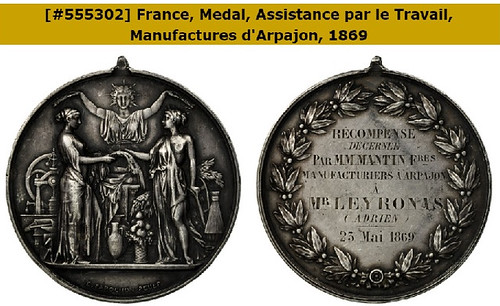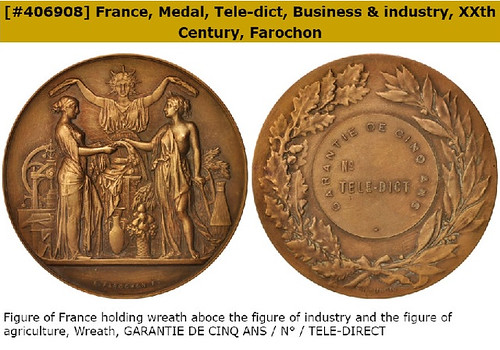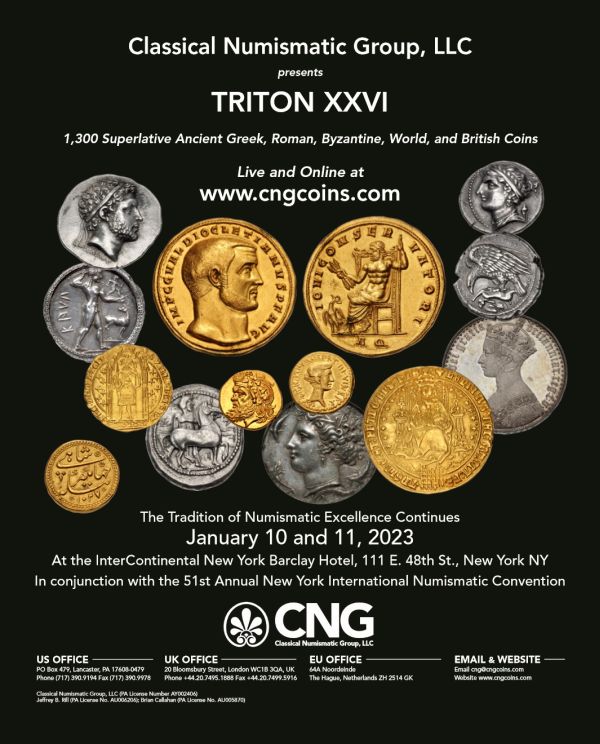
PREV ARTICLE
NEXT ARTICLE
FULL ISSUE
PREV FULL ISSUE
V25 2022 INDEX E-SYLUM ARCHIVE ON THE GODDESS OF SCIENCE & INDUSTRY
"The discussion reminded me of the following medal, whose reverse bears the figures of Marianne of France presumably crowning the goddess of Science and Industry on the left, and Ceres, goddess of Agriculture and Abundance on the right, engraved by Jean Baptiste Eugène Farochon, a design that was used on several French medals from 1864 until at least 1955. I would very much like to know the name of the goddess on the left, the one of science and industry. Thank you!" Pete Smith was the first to respond, with a one-word reply of "Minerva". -Editor Ken Berger writes: "I was very surprised to read that Alan Luedeking needed help in determining the name of the Goddess of Science & Industry. A simple Google search was all that was needed. The answer is Minerva." B.J. Herbison writes: "I'm probably not the first to reply, but Minerva would be the goddess of Science and Industry. It's not the standard Roman representation of Minerva but no other goddess qualifies." Pete Smith gave it some more thought and followed up with this response. -Editor
Minerva or Not?
An entry in The E-Sylum had a picture of a medal by Jean-Baptiste Eugene Farochon and the
comment, Minerva and Marianne never met. Allegorical figures may be identified by their attributes and Marianne often took on the attributes of Minerva. Without being told who is represented, it would be easy to confuse the two. The Roman Minerva is equivalent to the Greek Athena and both are seen with owls. A combative Minerva has armor, a helmet and spear. The figure on he left of the medal has none of the attributes of Minerva. Marianne on the medal wears a radiant crown, an attribute for Liberty and would represent the French Republic. The figure on the left has the attributes of machinery which, in different context, might represent Manufacturing or Industry. It has none of the attributes of Science. The Roman Ceres is the equivalent of the Greek Demeter. The medal has the personification of Agriculture on the right. Agriculture and Ceres share some attributes but Agriculture lacks some of the attributes that make Ceres distinctive. The woman on the medal is more youthful than the matronly Ceres. The Farochon image is reused for a variety of prize medals. I found three that illustrate the reuse of a theme with a reverse message that does not relate to the obverse image. This silver medal mentions Manufacturing but makes no reference to Agriculture. This bronze medal refers to a five-year warrantee with no reference to Industry or Agriculture. There is a reverse for the Society of Civil Engineers with the translated text stating they were recognized as a public utility by imperial decree. An imperial decree might justify presentation by Marianne. Would she be equally appropriate to present an award to a prize bull at a county fair? How do Industry and Agriculture relate to Civil Engineering? I am bothered that one side of the medal has no apparent relationship to the other. Is the iconography still valid? Would it be correct to describe this as Marianne presenting an award to Industry and Agriculture when the other side is not an award for Industry or Agriculture. At some point it is just a pretty picture with no relevance. I am bothered that I can't identify the purpose for the medal shown in The E-Sylum. How did the personifications relate to that medal? Manufacturing and Agriculture are two types of productivity that might be honored at a fair or exposition. Some have prize medals that are unique for that event. Some, like these, use a generic image for the obverse with a custom reverse. In my opinion, the two women standing at the sides are personifications of Industry and Agriculture and not Minerva and Ceres. I shared everyone's responses with Alan Luedeking, and here are his thoughts. -Editor The reason for my question was precisely the fact that I was not confident of the attribution to Minerva. I very much appreciate Pete Smith's carefully reasoned reply. But he need not fret over the relationship (or lack thereof) between the obverses and reverses of the medals that sport this die. There is none. I know this from the research I originally did on the extremely rare General Edward Porter Alexander medal that was awarded to him by Nicaragua in 1900. That medal used this same die for the reverse. In my article on the Alexander piece, I wrote the following: "Returning to the design of the Alexander medal, the Nicaraguan government undoubtedly wanted to save some of the manufacturing costs by commissioning A. Godard of Paris to create only one die (the obverse) and was content to use for the reverse a generic die already extant for other medals. This is evident from the fact that the obverse was custom made by engraver A. Godard whereas the reverse was made by Jean Baptiste Eugène Farochon, who was born in Paris on March 10, 1812 and died on July 1, 1871. Obviously then, engraver Farochon could not have engraved the reverse of Alexander's medal when it was only ordered in 1900. Furthermore, if the Paris engravers had been ordered to design the complete medal (i.e., both sides of same), the Godard firm would undoubtedly have assigned the project to the same engraver (in this case perhaps Godard himself) and not to two different engravers. As proof of these assumptions, let us look at the example below of a French commemorative silver medal that antedates the medal made for General Alexander by eight years. In this piece we see the same die by Farochon that was used for the reverse of the 1900 Alexander medal being used for the obverse of this silver medal issued in 1892, twenty-one years after Farochon's death, and eight years before the commissioning of the Alexander medal: [image of the medal follows] Thus, we can assert with complete confidence that the Republic of Nicaragua was content to save money on Alexander's medal by only commissioning the die for the obverse side of it and using the generic and unrelated but very attractive die created by Farochon for the reverse of the medal. In our opinion, engraver Godard did a fine job of assembling the desired elements ordered by Nicaragua onto this one side of the medal... [etc.]" Thanks again to all who gave this some thought. Thanks, everyone. -Editor
To read the earlier E-Sylum article, see:
Wayne Homren, Editor The Numismatic Bibliomania Society is a non-profit organization promoting numismatic literature. See our web site at coinbooks.org. To submit items for publication in The E-Sylum, write to the Editor at this address: whomren@gmail.com To subscribe go to: https://my.binhost.com/lists/listinfo/esylum All Rights Reserved. NBS Home Page Contact the NBS webmaster 
|



